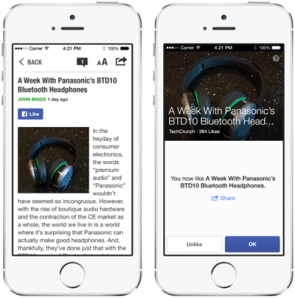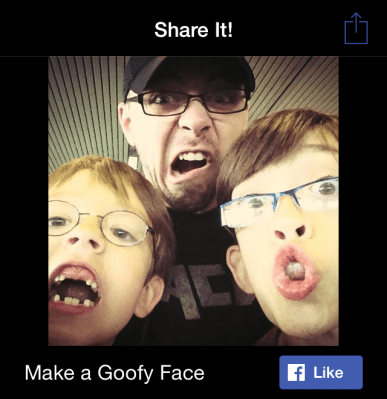Facebook has no plans to discontinue “implicit sharing” from third-party apps, likely because the data is still very valuable, but today the company said it will be favoring explicitly shared stories in the feed over auto-shares. Facebook isn’t giving up on auto-sharing; it just doesn’t want to show it all those Spotify listens, Instagram Likes, and more in the News Feed.
What that means is that if you formally open a “share to Facebook” window in a third-party app, add your own description or content, then post it to the News Feed, more of your friends are likely to see it. If you simply enabled a setting that auto-shares to Facebook every time you do something such as like a photo or listen to a song, that stuff is less likely to appear to friends.
 Facebook will still collect the auto-shared data about you, which it could use to target advertising, such as nearby concerts of bands you listen to. And that data will still appear in your Facebook profile. But Facebook likely found that users were less likely to click on these auto-shared stories than ones they knew their friends took the time and care to purposefully post.
Facebook will still collect the auto-shared data about you, which it could use to target advertising, such as nearby concerts of bands you listen to. And that data will still appear in your Facebook profile. But Facebook likely found that users were less likely to click on these auto-shared stories than ones they knew their friends took the time and care to purposefully post.
Facebook launched its Open Graph protocol at its 2011 f8 so developers could let users post their activity to Facebook from others apps without constantly being interrupted by sharing prompts. The program quickly gained steam as developers are always hungry for growth.
But Facebook over-flooded the feed and the now-mostly-dead Ticker with all the news friends were consuming in Open Graph news apps, listening to in Spotify or Rdio, and where they were running. These stories often felt lifeless and robotic compared to what people posted natively on Facebook or deliberately from other apps. A backlash ensued, Facebook changed its feed algorithm, and whole classes of apps like news readers (The Guardian, The Washington Post) and social video platforms (SocialCam, Viddy) cratered.
But in the end, that was good for the average Facebook user’s experience. Facebook writes that tests of the upgraded News Feed algorithm that showed fewer auto-shared stories reduced the total number of time stories shared from other apps were marked as spam by 75 percent.
Auto-sharing got a bad rap. But as I wrote back in 2011, the power was in aggregation. I don’t care if one friend listened to a song or read an article. But if 15 of my friends did in a single day, even if none of them shared it explicitly, that content is probably highly relevant. Auto-sharing let Facebook cobble together these aggregated stories about friends’ activity. And it still will, even if auto-shares about what a single friend does get hidden.
Developers may be somewhat less likely to integrate auto-sharing now that it doesn’t have as much feed reach, but most apps will take whatever growth they can get.

Facebook wants developers using its new mobile Like button instead of auto-sharing
The move ties in with Facebook’s f8 announcement of new explicitly sharing tools for mobile. Those include the mobile Like button, the Message option for private sharing to friends, and an improved explicit sharing dialog.
It also extends Facebook’s quest to clean up the News Feed, making it more personal and relevant and less susceptible to viral memes, like-baiting posts (“Please Like this!”), and click-bait news stories from sites like Upworthy. Because while Facebook wants to maintain a good relationship with developers, the user experience has to come first. If the feed gets boring, no one will read it, and it won’t matter what apps share there. It’s a complex dance, but Facebook would rather step on a few toes than break its own legs.
